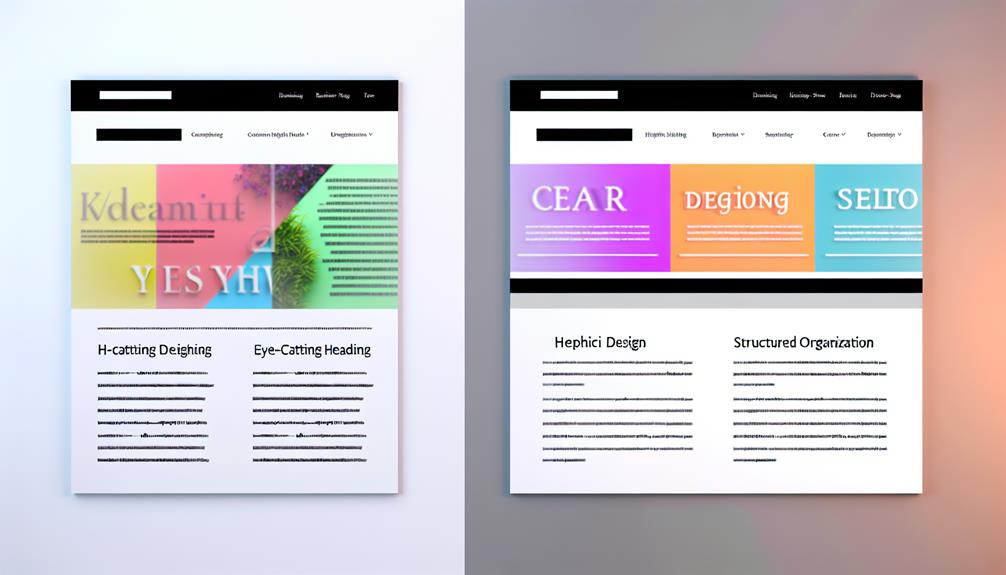Headings and headers, while often used interchangeably, serve unique purposes in web content. Headings, categorized from H1 to H6, establish a structured hierarchy that aids in readability and information organization, enhancing user engagement and assisting search engines in indexing. Headers, on the other hand, are broader elements that improve user experience and navigation across devices. Both are integral to SEO, with proper keyword usage enhancing visibility. Maintaining a logical arrangement fosters clarity and accessibility. Understanding these distinctions is essential for optimizing content effectively and achieving better search rankings. More insights on applying these principles will follow.
Key Takeaways
- Headings establish a content hierarchy (H1 to H6), enhancing readability and SEO, while headers influence user experience and navigation.
- Proper heading tags improve search engine understanding, aiding in content indexing and visibility.
- Headings enhance structure and organization, while headers focus on design consistency and accessibility across devices.
- Strategic keyword placement in both headings and headers boosts SEO performance and enhances user engagement.
- Clear visual hierarchy from headings aids quick information retrieval, while cohesive header design encourages prolonged reader interaction.
Understanding Headings

Understanding headings is vital for effective communication in both digital and print media. Headings serve as a roadmap, guiding readers through the content while establishing a heading hierarchy that enhances readability and comprehension. By organizing information strategically, headings create a structured framework that allows readers to navigate complex topics with ease. Notably, just as walking can provide a simple yet effective way to boost health, well-structured headings can greatly improve content engagement and clarity, as discussed in the surprising health perks of walking.
A clear heading hierarchy is important for maintaining semantic relevance. This hierarchy typically begins with H1, followed by H2, H3, and so forth, each level indicating the importance and relationship of the content beneath it. Properly utilized, headings not only aid in clarifying the theme of each section but also bolster SEO efforts by signaling to search engines the importance of the content.
Moreover, embracing a thoughtful approach to headings fosters a sense of belonging among readers. When they can quickly identify the main ideas and supporting details, engagement increases, driving a deeper connection with the material. To conclude, understanding and implementing effective headings is a strategic necessity for enhancing communication and ensuring that content resonates with its intended audience, ultimately promoting a more inclusive and informative experience.
Understanding Headers
Headers serve as critical elements in web content, influencing both user experience and search engine optimization (SEO). Just as low-calorie snacks can aid in effective weight management, utilizing headers strategically can enhance readability and engagement. Understanding the various types of headers and their strategic application can enhance content accessibility and improve rankings. This section will explore header types, their importance for SEO, and best practices for effective implementation.
Header Types Explained
In the domain of digital content creation, headers serve as essential navigational tools that enhance both readability and organizational structure. Understanding the various types of headers is vital for creating effective web content. Header tags, ranging from H1 to H6, establish a visual hierarchy that guides users through the content. The H1 tag is typically reserved for the main title, while subsequent tags provide a semantic structure that breaks down information into digestible sections.
This strategic use of header tags improves content accessibility, allowing users to scan and locate relevant information quickly. By adhering to coding standards, designers can guarantee that headers maintain design consistency across devices, which is especially important for mobile responsiveness. Each header type should be crafted with readability factors in mind, considering styling differences that affect user experience.
Incorporating headers effectively not only supports the flow of information but also aligns with best practices in digital design. By prioritizing these elements, content creators can foster a sense of belonging among their audience, enhancing engagement and satisfaction through well-structured and accessible content.
Importance for SEO
Effective use of header tags not only enhances user experience but also plays a significant role in search engine optimization (SEO). By structuring content with appropriate headings, websites can improve their visibility in search algorithms and facilitate better information retrieval. Here are four key reasons why headers are essential for SEO:
- Content Hierarchy: Headers establish a clear content hierarchy, guiding both users and search engines through the material.
- Readability Factors: Properly formatted headers enhance readability, making it easier for users to find relevant information quickly, thereby improving user engagement.
- Visual Hierarchy: Headers create a visual hierarchy that aids in mobile optimization, ensuring that content is accessible and easily digestible on smaller screens.
- Semantic Markup: Utilizing header tags as semantic markup helps search engines better understand the context and relevance of the content, impacting rankings positively.
Incorporating these elements not only boosts user experience but also aligns with best practices for content accessibility. By leveraging header tags effectively, websites can foster a sense of belonging among users, encouraging them to engage with the content meaningfully.
Best Practices Overview
The strategic implementation of header tags is essential for optimizing content structure and enhancing user navigation. By establishing a clear content hierarchy, headers guide readers through your material, making it easier to digest complex information. This systematic arrangement not only aids in comprehension but also contributes considerably to a positive user experience.
To maximize the effectiveness of headers, it is important to maintain a logical order, starting with H1 for the main title, followed by H2 for main sections, and H3 for subsections. This hierarchy helps both users and search engines understand the relationships between different content elements. Additionally, using relevant keywords within headers can improve SEO performance, making your content more discoverable.
Moreover, it is advisable to limit the use of headers to maintain clarity. Overloading your content with numerous headings can confuse readers and dilute the intended message. Instead, focus on creating a cohesive structure that encourages engagement and retention.
Importance of Headings in SEO

Headings play a critical role in both the structure and organization of content, enhancing readability and user experience. They also help search engines understand the main topics of a page, which can lead to better indexing. By strategically incorporating relevant keywords into headings, websites can improve their search engine rankings and visibility. For instance, using headings effectively can guide users to top mattress toppers for back pain relief while maneuvering through content. Understanding the significance of headings in SEO is essential for optimizing content effectively and ensuring it meets both user and algorithmic expectations.
Structure and Organization
Understanding the role of headings in structuring content can greatly impact SEO performance. Effective use of headings enhances content organization, improves user experience, and boosts readability factors. A well-defined content hierarchy provides clarity, guiding readers through the material while also aiding search engines in indexing.
Here are four critical aspects to evaluate:
- Semantic Markup: Utilizing proper heading tags (H1, H2, H3) allows search engines to understand the content's structure, which is essential for effective indexing.
- Visual Structure: A clear visual hierarchy not only enhances aesthetic appeal but also facilitates easier navigation, keeping users engaged and reducing bounce rates.
- Accessibility Considerations: Properly structured headings improve accessibility for users with disabilities, ensuring that all readers can navigate your content seamlessly.
- Navigation Enhancement: Well-organized heading structures provide a roadmap for users, making it easier to find relevant information quickly.
Incorporating these elements creates a cohesive experience that benefits both users and search engines, ultimately leading to improved SEO performance. Prioritizing structure and organization in your headings is not merely a technical task; it's an essential strategy for online success.
Keyword Optimization Strategies
Incorporating targeted keywords within headings is a pivotal strategy for enhancing SEO performance. By strategically placing relevant keywords in headings, you not only improve visibility in search engine results but also establish content relevance, which is essential for engaging your audience. Effective keyword research lays the foundation for this process, allowing you to identify the terms that resonate most with your target demographic.
Headings serve as signposts for both users and search engines, guiding them through your content. When keywords are embedded in headings, they signal the main topics of your content, improving the likelihood of retaining reader interest and boosting search rankings. This alignment fosters a sense of belonging among readers, as they find the information they seek effortlessly.
Moreover, utilizing a hierarchy of headings (H1, H2, H3) enhances clarity and organization, further aiding SEO efforts. Each heading should reflect the content it precedes, incorporating keywords naturally without compromising readability. Balancing keyword usage with user experience is key; overstuffing can detract from content quality. Consequently, a thoughtful approach to keyword optimization within headings is fundamental to achieving sustained SEO success and building a loyal readership.
Importance of Headers in SEO
Effective headers play an essential role in optimizing web content for search engines, serving as both signposts for users and signals for search algorithms. Just as Kelly Clarkson's weight loss journey showcases the importance of making informed choices, properly structured headers enhance user experience while aligning with SEO best practices, particularly through the use of header hierarchy and semantic markup. Kelly Clarkson's inspiring choices serve as a reminder that clarity and organization are key in any successful endeavor.
Here are four key reasons highlighting the importance of headers in SEO:
- Improved Readability: Well-defined headers break up text, making it easier for users to scan and comprehend content.
- Enhanced User Engagement: Engaging headers can capture attention, encouraging visitors to stay longer on your page and explore further.
- SEO Signals: Search engines prioritize pages with clear header structures, interpreting them as more relevant to user queries.
- Content Organization: A logical header hierarchy organizes information, guiding both users and search engines through your content effectively.
Best Practices for Headings

One key aspect that content creators often overlook is the strategic use of headings to enhance both user experience and SEO performance. Establishing a clear heading hierarchy is vital; it guides readers through content, making it easier to digest and navigate. For instance, students looking for flexible work can benefit from flexible remote customer service jobs, which highlight the importance of well-structured content in attracting the right audience. Utilize semantic markup effectively, guaranteeing that headings reflect the structure and topic of sections accurately. This not only aids search engines in understanding content but also improves accessibility considerations for users employing assistive technologies.
Additionally, thoughtful keyword placement within headings can greatly bolster SEO efforts while maintaining content readability. Avoid keyword stuffing; instead, focus on integrating relevant terms naturally. Visual design also plays an important role; confirm that headings are distinct and visually appealing, enhancing the overall user experience.
In today's mobile-centric world, mobile optimization is paramount. Verify that headings render well on smaller screens, facilitating easy scanning and comprehension. By adhering to these best practices, content creators can foster a sense of belonging among readers, guiding them through a well-structured and engaging narrative. Ultimately, the strategic use of headings can transform content into a more accessible, readable, and enjoyable experience, aligning with both user needs and SEO goals.
Best Practices for Headers
Headings serve as a guide for readers, but headers play a different yet complementary role in content organization. To maximize the effectiveness of headers, consider the following best practices:
- Establish a Clear Header Hierarchy: Use a logical structure with H1, H2, H3, etc., to convey the importance and relationship of information. This enhances content organization and aids user experience.
- Implement Semantic Markup: Utilize HTML tags properly to reflect the content's context. This not only improves SEO but also guarantees that screen readers can interpret the content correctly, addressing accessibility considerations.
- Apply Effective Formatting Techniques: Use bold, italics, and color variations judiciously to enhance the visual impact of headers. This engages readers and makes content skimmable, improving overall user experience.
- Focus on Design Aesthetics: Confirm headers align with the overall design of the webpage. Cohesive aesthetics encourage readers to stay longer, fostering a sense of belonging within the content.
Frequently Asked Questions
Can I Use the Same Heading Multiple Times on a Page?
Using the same heading multiple times on a page can disrupt the heading hierarchy, which is essential for effective content organization. Each heading should serve a unique purpose, guiding readers through the material and enhancing comprehension. Repeating headings may confuse users and hinder their navigation experience. To maintain clarity and structure, it is advisable to use distinct headings that accurately reflect the content's distinct sections, thereby fostering a more cohesive reading experience.
How Do Headings Affect User Experience on My Site?
Headings greatly influence user experience by establishing a clear heading hierarchy that guides readers through content. A well-structured hierarchy enhances user engagement, as it allows visitors to quickly identify relevant sections and navigate your site efficiently. By strategically employing headings, you can create a logical flow of information, fostering a sense of belonging and connection with your audience. This approach not only facilitates comprehension but also encourages users to remain on your site longer.
What HTML Tags Are Used for Headers?
HTML tags designated for headers primarily include '
', '
', '
', and so forth, reflecting a structured header hierarchy. This hierarchy conveys semantic importance, guiding both users and search engines through the content's organization. Utilizing these tags effectively not only enhances readability but also improves accessibility, ensuring that all visitors can engage with the material. Strategically employing these elements fosters a sense of belonging and clarity within the digital experience.
Are There Any Tools to Analyze Headings and Headers?
', and so forth, reflecting a structured header hierarchy. This hierarchy conveys semantic importance, guiding both users and search engines through the content's organization. Utilizing these tags effectively not only enhances readability but also improves accessibility, ensuring that all visitors can engage with the material. Strategically employing these elements fosters a sense of belonging and clarity within the digital experience.
Are There Any Tools to Analyze Headings and Headers?
Yes, various tools can effectively analyze heading hierarchy and header structure within web pages. Tools such as Google Search Console, Screaming Frog, and SEMrush provide insights into how headings are utilized, ensuring proper organization and optimization. These platforms allow users to evaluate the effectiveness of their headings and headers, helping to improve user experience and search engine visibility. By strategically refining these elements, website owners can enhance their content's clarity and accessibility.
Can I Style Headings Differently From Headers?
Yes, you can style headings differently from headers. By utilizing CSS, you can strategically apply unique styles to various heading levels, ensuring visual distinction while adhering to a proper heading hierarchy. This enhances readability and user experience. Additionally, header placement can be customized to fit design preferences, allowing for a cohesive look across the webpage. Implementing these styling techniques thoughtfully can contribute to an engaging and well-structured online presence, promoting a sense of belonging among users.




